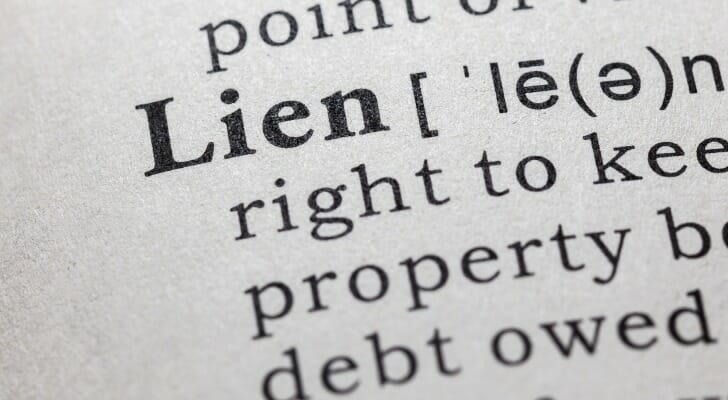If you fail to pay taxes as a business owner, the government could slap your business with a tax lien. Filed by the Internal Revenue Service, this document places a legal claim against your business property, including bank accounts, equipment and buildings. It also serves as a notice to creditors that the government has claimed a legal right to your property. Here’s how to deal with a tax lien on your business.
Consider working with a financial advisor for help formulating a plan to reach your goals.
Tax Lien Risks
A tax lien is an official notice from the federal government before it seizes and sells your property to pay past-due taxes. If you don’t take action to address the lien, you are likely to lose your property.
It is important to note that a tax lien is not the same as the IRS actually seizing your assets, which is known as a tax levy. The tax lien simply serves as a notice informing creditors that the tax authorities are claiming your property.
However, because a tax lien is a public notice, any creditor you try to borrow from is likely to find out about the tax lien.
Additionally, an IRS tax lien comes before any other creditor’s claim, so a business subject to a tax lien filed is likely to have great difficulty borrowing money. That includes borrowing money to pay your outstanding tax obligation.
Depending on the type of business, the tax lien can affect the owner’s personal assets. For example, corporations and limited liability companies (LLCs) with tax liens may find their assets affected. Sole proprietors, on the other hand, may find their personal assets claimed by the federal government.
Tax Lien Process
If you fail to pay taxes due, you will likely receive a Notice of Federal Tax Lien from the IRS.
Each year, the IRS files hundreds of thousands of such tax liens. During the 2009 recession, the IRS filed 1 million tax liens in one year alone. That number has drastically reduced over the years, with fewer than 200,000 notices filed in 2024. 1 Although tax liens are common, that doesn’t mean they should be taken casually.
A tax lien starts with not paying taxes that are due. Once the IRS takes note of the overdue taxes, the taxpayer’s business will be sent a Notice and Demand for Payment.
If the business fails to pay within 10 days of receiving the demand for payment, the Notice of Federal Tax Lien is next. Unless this tax lien is dealt with, the IRS could soon start seizing assets.
Dealing With a Tax Lien
The best way to avoid a tax lien is to pay taxes on time. That is, when they are due or, at least, after receiving a Notice and Demand for Payment.
Once the tax lien notice has been filed, the business can still resolve matters by paying the debt in full. If this is done, the IRS will remove the tax lien within 30 days.
Withdrawal
One way to address the tax lien is to request its withdrawal. However, this is only available in certain circumstances.
- If you pay the overdue tax liability
- If you are up to date on all filings for the past three years
- If you are current on estimated taxes and tax deposits
A business may also get the lien withdrawn before the debt is paid, although the business must still pay the debt eventually. To do this, a business must:
- Owe less than $25,000.
- Set up an IRS installment loan with direct debit payments and a maximum 60-month term.
- Make three consecutive direct debt payments.
- Have no history of defaulting on other direct debit installment agreements with the IRS.
It’s best to seek an IRS loan upon receipt of the original Notice and Demand for Payment.
Discharge of Property
Discharge of property is another method for coping with a tax lien, as it can remove the lien from specific property.
The IRS will only discharge specific property if enough property remains on the lien to pay the tax owed. However, if possible, removing a specific property from the lien may help your business raise the necessary funds to satisfy the lien.
Subordination
Another option is to have the lien subordinated. This means the IRS is willing to take second place behind other creditors. By doing so, this allows the business to borrow money elsewhere to pay the lien.
This may also enable the restructuring of the business’s debt, freeing up enough cash flow to pay the tax bill.
Preventive Practices for Business Tax Compliance

There are some things you can do to help ensure you stay on top of your taxes.
Establish a Routine
Many businesses reduce the chance of tax trouble by establishing consistent routines for tracking income, expenses and required payments. A simple recordkeeping system makes it easier to see what is owed and when it is due. This can help prevent missed deadlines that lead to penalties and collection activity.
Set Reminders
Setting up scheduled reminders for payroll deposits, estimated taxes and filing dates can also help a business stay current. Some owners automate tax payments through their bank or payroll provider to avoid delays during busy periods.
While these steps do not remove tax obligations, they can help keep payments on a regular schedule.
Keep Complete Records
Accurate financial records are important during the year, not just at filing time. Keeping receipts, invoices and payroll data organized supports timely filings and reduces the risk of errors that might trigger IRS notices. Clear records also make it easier to respond quickly if the IRS requests additional information.
Consult a Professional
Many business owners meet with an accountant or tax professional during the year, not only at tax season. These check-ins can help identify changes that affect taxes, such as hiring employees, shifting business income or adjusting estimated payments. Catching issues early may reduce the chance of falling behind later.
Annual reviews of past filings, payment patterns and operational changes can highlight weak spots in a business’s tax process. If the business has grown, opened new locations or changed its structure, those changes can affect tax obligations.
Regular reviews help keep the business aligned with current requirements while lowering the likelihood of lien activity.
Bottom Line

If the IRS files a Notice of Tax Lien against your business, dealing with it has to become a priority. The best way to handle a tax lien is to avoid it by paying taxes when due. If one is received, however, there are options to lessen the potentially catastrophic impact of a tax lien.
Tips for Dealing With a Tax Lien
- Consider talking to a financial advisor about how to avoid having your business served a tax lien or to help you properly create a tax plan. Finding a financial advisor doesn’t have to be hard. SmartAsset’s free tool matches you with vetted financial advisors who serve your area, and you can interview your advisor matches at no cost to decide which one is right for you. If you’re ready to find an advisor who can help you achieve your financial goals, get started now.
- The Internal Revenue Service isn’t the only agency that can file a tax lien. State and local taxing authorities can also claim your business assets if you don’t pay taxes due.
Photo credit: ©iStock.com/Ridofranz, ©iStock.com/mediaphotos, ©iStock.com/Devonyu
Article Sources
All articles are reviewed and updated by SmartAsset’s fact-checkers for accuracy. Visit our Editorial Policy for more details on our overall journalistic standards.
- “SOI Tax Stats – Delinquent Collection Activities – IRS Data Book Table 27 | Internal Revenue Service.” Home, https://www.irs.gov/statistics/soi-tax-stats-delinquent-collection-activities-irs-data-book-table-27. Accessed 24 Nov. 2025.
